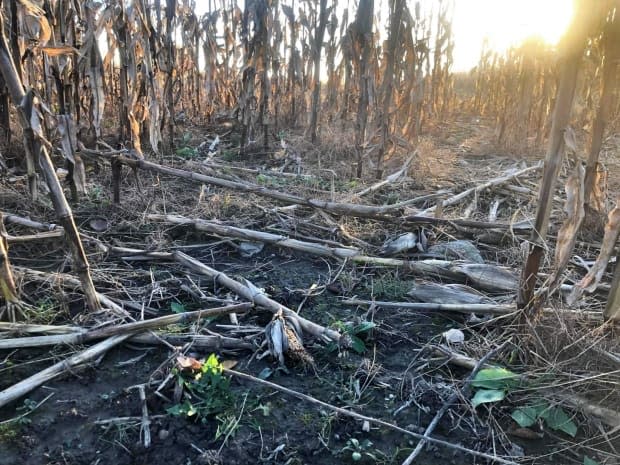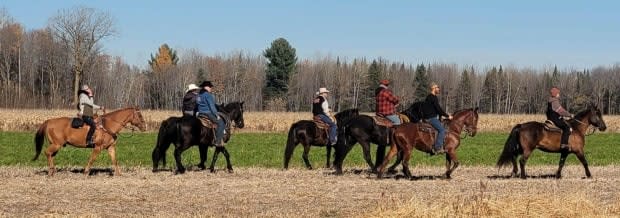Fugitive cows in Quebec captured after months on the run

The last cows part of Quebec's run-away herd of Holsteins were captured and returned home Saturday, said the local union for agricultural producers, UPA Mauricie.
The herd of more than 20 dairy cows had been on the run since July, when they were spooked by a summer thunderstorm on a dairy farm near Saint-Barnabé, close to Trois-Rivières, Que.
Since then, they had been contentedly grazing wherever they liked — and wreaking havoc on farmers' fields nearby.
But starting last month, UPA Mauricie led the efforts to capture the cows.
At the beginning of December, an enclosure was set up with the goal of attracting the cows with food, said Jean-Sébastien Dubé director of communications for the Fédération de l'UPA de la Mauricie.
"With a feeding point inside the enclosure, the goal was to attract the animals to the inside of the enclosure and that they adopt different eating routines," said Dubé, adding that the weather was on their side, with the winter bringing in cold temperatures and snow that covered up other possible food sources.
"The food was less available on the ground so it made the cows more dependent on the food we were offering."

In December they captured four cows. Now, the UPA Mauricie says it has recovered 13 cows and two calves that were born during the cows time on the lam. Dubé says about 20 people helped capture the animals.
Just in case: enclosures up until Wednesday
Jean-Yves St-Arnaud, the mayor of Saint-Sévère, says he was happy to hear that the UPA Mauricie effort, along with the help of Quebec's Agriculture Ministry was a success.
"My first reaction was that I was very happy and pleased about the situation. But also with a bit of caution," said St-Arnaud, adding that he wants to make sure they didn't miscount the Holsteins.
"We asked [them] to leave the enclosures up until Wednesday thinking there could be two to three more cows, in the case of an error in our calculations. Some people said there were 24 cows, others say 27 or 28."
Cows adapting well to farm life
Dubé says the animals seem to be in good shape and are back on the farm.
"There were experts in bovine production who visited the farm before the return of the animals to ensure optimal conditions. And ever since their return, they are adapting super well," said Dubé
Their owner, Pierre Lapointe, a dairy producer in Saint-Barnabé, says the cows are being kept in the barn so they can get used to the other animals.
He expects they will be able to return to the fields next summer once they are used to the fences and herd life.
Tens of thousands of dollars in damages
The cows' adventures may have seemed heroic or amusing to the public, but St-Arnaud says it was quite serious for some local farmers.
He estimated the fugitive cows caused tens of thousands of dollars of damage as they trampled or ate crops under cover of darkness.
"When it comes to corn, they eat the top half of it, and leave the bottom half and then the rain goes inside of it," said St-Arnaud. "So a crop [is] completely lost."

He says around seven farmers contacted him near the end of October about the situation, but the village — population 812 — initially couldn't help because it involved private property.
"When animals stay on private property, we as a municipality cannot intervene," said St-Arnaud. "Around the last week of October … We started asking questions and we intervened once we realized they were going on the road."
Although the next step was to contact governmental organizations such as Quebec's Agriculture Ministry and the Ministry of Forests, Fauna and Parks, St-Arnaud said the city received conflicting replies — about whose jurisdiction covered cows that have run wild.
Capture comes after rodeo cowboys failed in October
The capture of the cows comes after a failed mission in October involving eight Saint-Tite cowboys. St-Arnaud said that mission was Plan Z, a last resort, with the crew working a long 12-hour day.
"They lent us barriers which measure six feet, so that the cows don't jump over it, and eight cowboys and a drone operator. We were well-equipped," said St-Arnaud.

Although it looked like the cowboys had triumphed with the cows successfully corralled into a pen, one managed to escape. From there, everything went south and the herd was on the loose again.
"They gathered into the corn fields and into the woods and we lost them," said St-Arnaud.
He says the community is happy the situation is now under control. One of St-Arnaud's primary concerns was how the cows posed a major risk to drivers.
"Right now there is no more danger, the cows aren't there. We're returning to normal," said St-Arnaud.


